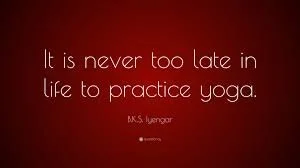“The study of asana is not about mastering posture. It is about using posture to understand and transform yourself.” ~ BKS Iyengar
What My Assessment Weekend Entails
The Two Wings of Yoga: Practice and Detachment
How easily are you fooled by your own mind?
Anger Appears Unannounced
Arogya Yoga: Chapter 17, Swastikasana Chakra (cycle)
Swastikasana is one of the basic sitting poses. From the last chapter, we learned that the Sanskrit word for quiet or still is svastha literally means “to be contained within the Self”
In this chapter he talks about how the Swastikasana cycle should be practiced for the relief of minor or chronic ailments. One of the benefits of this asana and the sequence he recommends is that it can be practiced anywhere, such as sitting on your bed, or on the floor of your room when you are travelling.
There are three poses in the sequence, performed with the legs in Swastikasana:
1. Urdhva Baddhangulyasana: fingers inter-laced, arms stretched overhead.
a. Make sure you do both the dominant and non-dominant finger interlocks with the right leg in first and then again with the left leg in first.
2. Parivrtta Swastikasana: twisting to the side and reaching to the side
a. Twist to the right and left with the left leg folded in first and then repeat twisting to both sides with the right leg folded in first
3. Adho Mukha Swastikasana: folding forward.
a. Fold forward with the right leg folded in front first and then repeat with the left leg folded in first
You can perform each one of these positions one-at-a-time by themselves, or you can do all three in order, first with the right leg folded in first and then with the left leg folded in first.
You can read about the poses and how to do them in the chapter I included here.
Mr. Iyengar says:
“The sequence of asanas has been carefully designed. The body is first vertically extended, which evenly elongates the flanks and minimizes the occurrence of cramps when rotating to the side. The combination of rotational and side bending action creates further suppleness in the trunk. Alternately lengthening each side of the trunk ensures tha the lower back and abdomen do not harden when eventually folding forward in the last variation. At every stage of the cycle, one becomes aware of increased freedom and mobility in the body.”











